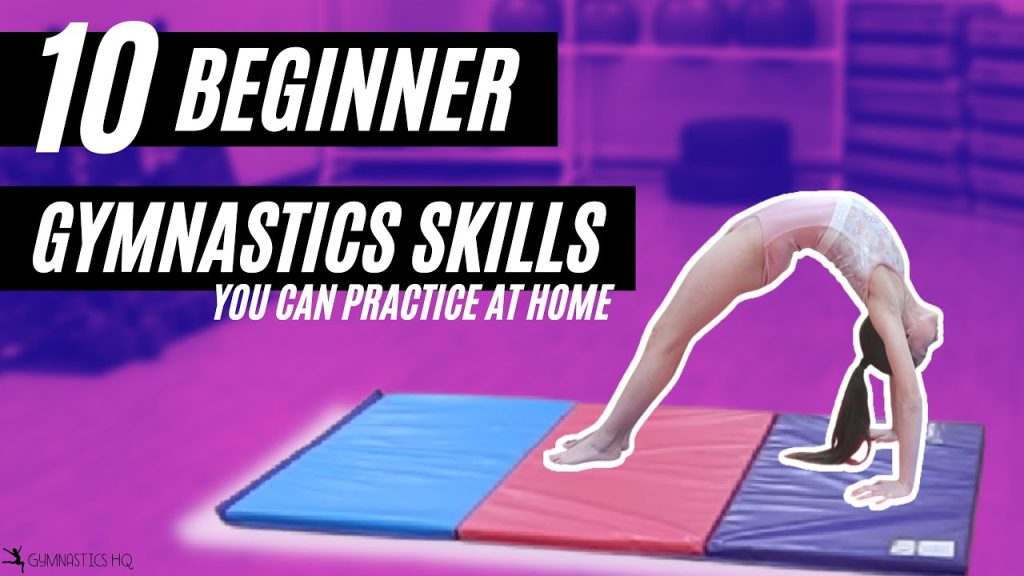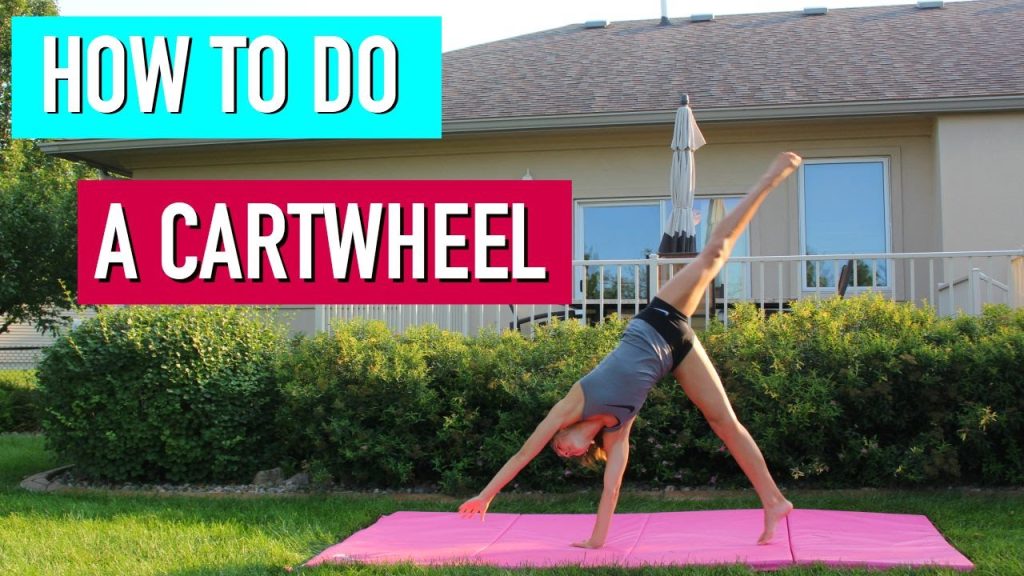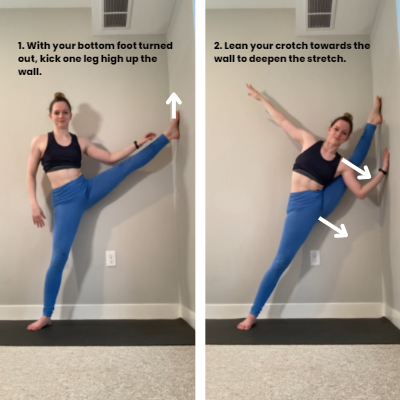Gymnastics is an exciting and challenging sport. It requires strength, flexibility, and balance.
Learning how to do gymnastics can seem tough, but it’s possible for anyone to start. With the right guidance and practice, you can master the basics. Gymnastics improves physical fitness and boosts mental focus. This guide will take you through the steps to begin your gymnastics journey.
From simple stretches to basic moves, you will learn how to train safely. Let’s dive into the world of gymnastics and discover how fun and rewarding it can be.

Credit: www.wikihow.com
Introduction To Gymnastics
Gymnastics is a sport that combines strength, flexibility, and grace. It is an excellent way to improve overall fitness. Many people start gymnastics at a young age, but it is never too late to begin. Whether you want to compete or just stay fit, gymnastics offers many benefits. Let’s dive into its history and advantages.
Brief History
Gymnastics dates back to ancient Greece. It was part of the Olympic Games in 776 BC. The word “gymnastics” comes from the Greek word “gymnos,” meaning naked. Greek athletes trained without clothes to improve their skills. In the 19th century, gymnastics became popular in Europe. Modern gymnastics events were introduced at the first modern Olympic Games in 1896. Today, it is a well-loved sport worldwide.
Benefits Of Gymnastics
Gymnastics offers numerous physical and mental benefits. It helps build strength and flexibility. Regular practice improves balance and coordination. Gymnasts develop strong muscles and healthy bones. They also learn discipline and perseverance. The sport encourages a healthy lifestyle. It can boost self-confidence and reduce stress. Kids and adults alike can benefit from gymnastics training. It is a fun and engaging way to stay fit and active.

Credit: www.wikihow.com
Essential Equipment
Starting gymnastics requires the right equipment. Proper gear ensures safety and enhances performance. Knowing the essential equipment is crucial for beginners and seasoned gymnasts alike. Let’s dive into the key items you need to start your gymnastics journey.
Gymnastics Attire
Wearing the right attire is important for gymnastics. Leotards are the most common clothing for gymnasts. They allow for a full range of motion. Leotards come in various colors and designs. Choose one that fits well and feels comfortable.
Boys often wear tight-fitting shirts and shorts. This attire also allows for easy movement. Avoid loose clothing. It can get caught on equipment. Proper attire helps coaches see your body alignment. This makes it easier to correct your form.
Basic Gear
Basic gear includes items like grips, wristbands, and mats. Grips protect your hands. They also help you hold onto the bars better. Wristbands provide extra support and reduce the risk of injury.
Mats are essential for safety. They cushion falls and reduce impact. You will find mats in various thicknesses. Thicker mats are used for higher risk activities. Thinner mats are for basic skills and stretching.
Another piece of basic gear is the balance beam. It helps improve balance and coordination. Beginners often start with a low beam. As skills improve, they move to higher beams.
Warm-up Exercises
Warm-up exercises are essential before starting any gymnastics routine. They prepare your body for the intense movements gymnastics requires. A good warm-up increases blood flow, enhances flexibility, and reduces the risk of injury. Here’s how to get started with effective warm-up exercises.
Stretching Techniques
Stretching helps improve flexibility and range of motion. Begin with basic stretches like touching your toes. This stretch targets the hamstrings. Hold the position for 20 seconds. Next, try the butterfly stretch. Sit on the floor, bring your feet together, and gently press your knees down. Hold for 20 seconds. Lastly, do the shoulder stretch. Extend one arm across your body and use the other arm to press it closer. Hold for 20 seconds. Repeat on the other side.
Cardio Warm-ups
Cardio warm-ups get your heart rate up and muscles warm. Start with jumping jacks. Do them for one minute. Next, try high knees. Run in place, lifting your knees as high as possible. Continue for one minute. Then, do butt kicks. Run in place, kicking your heels toward your glutes. Keep going for one minute. These exercises help to increase your heart rate and prepare your muscles for gymnastics.
Basic Gymnastics Moves
Embarking on your gymnastics journey can be exciting. Mastering basic moves is the first step. These foundational skills build strength and coordination. They also prepare you for more complex techniques. Let’s dive into some essential gymnastics moves.
Forward Roll
The forward roll is a basic move. It teaches balance and body control. Start by standing straight with feet together. Bend your knees and place your hands on the ground. Tuck your chin to your chest. Push off with your legs and roll forward. Use your hands to guide the roll. Finish by standing up smoothly. Practice slowly to avoid dizziness.
Handstand
The handstand is a core gymnastics skill. It builds upper body strength. Begin by standing tall. Raise your arms overhead. Step forward with one foot. Place your hands on the ground. Kick your legs up together. Keep your body straight. Hold the position for a few seconds. Come down gently by lowering one leg. Practice against a wall for support.
Improving Flexibility
Improving flexibility is crucial for success in gymnastics. Flexibility enhances your performance and reduces the risk of injury. Here are some effective ways to improve your flexibility.
Stretch Routines
Incorporate various stretch routines into your daily practice. These routines should target different muscle groups. Here is a simple routine to get started:
- Warm-up: Light jogging or jumping jacks for 5 minutes.
- Forward Bend: Touch your toes and hold for 20 seconds.
- Side Stretch: Reach your arm over your head and lean to the side. Hold for 20 seconds on each side.
- Quadriceps Stretch: Stand on one leg, pull the other leg back, and hold for 20 seconds. Switch legs.
- Butterfly Stretch: Sit with your feet together and knees apart. Gently press your knees down and hold for 30 seconds.
- Calf Stretch: Stand facing a wall, place one foot behind you, and press your heel down. Hold for 20 seconds and switch legs.
Remember to breathe deeply during each stretch. This helps relax your muscles and improve flexibility.
Consistency Tips
Consistency is key to improving flexibility. Follow these tips to make stretching a habit:
- Set a Schedule: Stretch at the same time every day. Morning or evening works best.
- Start Slow: Begin with short sessions and gradually increase the duration.
- Track Progress: Keep a journal of your flexibility improvements. Note how far you can stretch each week.
- Stay Motivated: Celebrate small milestones. Reward yourself for sticking to your routine.
- Listen to Your Body: Avoid pushing too hard. Stretch to the point of mild discomfort, not pain.
By following these tips, you can steadily improve your flexibility and become a better gymnast.
Building Strength
Building strength is essential for gymnastics. It helps with balance, agility, and preventing injuries. This section will guide you through key exercises to build strength. Focus on your core and upper body to improve your performance.
Core Exercises
The core is the foundation of gymnastics strength. Strong core muscles improve balance and stability.
- Planks: Keep your body straight. Hold the position for 30-60 seconds.
- Leg Raises: Lie on your back. Lift your legs without bending your knees.
- Russian Twists: Sit with knees bent. Twist your torso side to side.
Perform these exercises regularly. They will enhance your core strength and stability.
Upper Body Workouts
Upper body strength is crucial for gymnastics. It helps in lifts and holds.
- Push-Ups: Keep your body straight. Lower yourself until your chest touches the ground.
- Pull-Ups: Use a pull-up bar. Pull yourself up until your chin is above the bar.
- Dips: Use parallel bars. Lower your body until your elbows are at a 90-degree angle.
Include these workouts in your routine. They will boost your upper body strength for gymnastics.
Safety Tips
Gymnastics is a fun and challenging sport. But it can also be risky. Staying safe is crucial. Here are some essential safety tips to keep in mind.
Proper Technique
Using the proper technique is very important in gymnastics. Always warm up before you start. Stretch your muscles to prevent injuries. Follow your coach’s instructions carefully. Practicing the right moves helps avoid mistakes. Remember to breathe steadily during routines. Keep your body aligned and balanced. This reduces the risk of falls.
Avoiding Injuries
Avoiding injuries should be your top priority. Here are some tips:
- Wear appropriate gear like leotards and grips.
- Use mats to cushion falls.
- Stay hydrated to keep your muscles flexible.
- Listen to your body. Stop if you feel pain.
Do not overtrain. Your body needs rest to recover. Follow a balanced diet to stay strong and healthy. Ensure you get enough sleep. This helps your body heal and grow.
If you have any previous injuries, tell your coach. They can adjust your training to suit your needs. Use protective equipment like wrist guards. This can prevent common injuries.
| Tip | Why It’s Important |
|---|---|
| Warm Up | Prepares muscles for activity |
| Follow Coach’s Instructions | Ensures correct technique |
| Use Mats | Prevents injuries from falls |
| Stay Hydrated | Keeps muscles flexible |
| Rest | Allows body to recover |
Finding A Gymnastics Class
Finding the right gymnastics class is essential for beginners. A good class helps you learn the basics safely. It also ensures steady progress and keeps you motivated. Let’s explore some ways to find the perfect gymnastics class for you.
Local Gym Options
Your local gym is a great place to start. Many gyms offer beginner gymnastics classes. These classes are often taught by experienced coaches. Check your community center or local sports complex. They may have information on available programs.
Visiting a few gyms can help you decide. Observe a class or talk to the coach. This gives you a sense of the teaching style. Ask about class sizes and safety measures. Smaller classes mean more individual attention. Safety protocols are crucial for avoiding injuries.
Online Resources
Online resources can also help you find gymnastics classes. Websites like ClassPass or Mindbody list local gym options. These platforms provide reviews and ratings. This feedback helps you choose the best class.
Social media is another valuable tool. Join local community groups on Facebook. Members often share recommendations and experiences. You can also search for gymnastics hashtags. This can lead you to classes and instructors in your area.
Finally, YouTube offers free tutorials for beginners. Channels like GymnasticsHQ and My Gymnastics Tutor provide quality content. These resources can supplement your learning. But, nothing beats the guidance of a live coach.
Tracking Progress
Tracking your progress is vital in gymnastics. It helps you see your improvements and stay motivated. Plus, it can help you identify areas that need more focus. Here are some effective ways to track your progress.
Setting Goals
Setting goals is the first step in tracking your progress. Goals give you a clear direction and something to strive for. Make sure your goals are specific, measurable, achievable, relevant, and time-bound (SMART).
- Specific: Define exactly what you want to achieve.
- Measurable: Make sure you can track your progress.
- Achievable: Set realistic goals that you can reach.
- Relevant: Ensure your goals are important to you.
- Time-bound: Set a deadline for your goals.
For example, a goal could be to master a cartwheel within three months. This goal is specific, measurable, achievable, relevant, and time-bound.
Keeping A Journal
Keeping a journal is another great way to track your progress. Write down your goals, workouts, and achievements. This helps you see how far you’ve come and what you need to work on.
Here is a simple table format to organize your journal entries:
| Date | Goal | Workout | Achievement |
|---|---|---|---|
| 01/01/2023 | Master cartwheel | Cartwheel drills | Improved form |
| 08/01/2023 | Master cartwheel | Cartwheel drills | Perfected cartwheel |
Regularly updating your journal keeps you focused and aware of your progress. Review your entries to identify patterns and areas for improvement.

Credit: m.youtube.com
Staying Motivated
Staying motivated in gymnastics can be challenging, but it is essential for success. It’s normal to face obstacles and feel discouraged at times. With the right mindset and strategies, you can stay on track and achieve your goals.
Overcoming Challenges
Challenges are a part of any journey. In gymnastics, you might struggle with new skills or fear getting hurt. Stay positive and focus on your progress. Break down complex moves into smaller steps. This makes them easier to learn and less overwhelming.
Seek support from coaches and teammates. They can provide guidance and encouragement. Remember, everyone faces challenges. It’s how you handle them that matters.
Celebrating Milestones
Celebrate your achievements, no matter how small. Reaching a new skill level or perfecting a move deserves recognition. Celebrating milestones keeps you motivated and reminds you of your progress.
Keep a journal of your gymnastics journey. Write down your goals and track your improvements. This visual record can be very motivating. Share your successes with friends and family. Their support can boost your confidence and keep you going.
Frequently Asked Questions
What Are The Basic Skills In Gymnastics?
Basic skills in gymnastics include handstands, cartwheels, forward rolls, and splits. These foundational moves build strength, flexibility, and balance. Mastery of these skills is essential for progressing to more advanced techniques.
How Can Beginners Start Gymnastics?
Beginners should start with a warm-up, basic stretches, and simple skills like rolls and handstands. It’s important to practice regularly and consider joining a class for proper guidance.
What Equipment Is Needed For Gymnastics?
Essential equipment for gymnastics includes a mat, bars, beam, and rings. Comfortable clothing and good shoes are also important for safety and performance.
How Often Should You Practice Gymnastics?
Practice gymnastics at least 3-4 times a week to see consistent improvement. Regular practice helps build strength, flexibility, and technique.
Conclusion
Learning gymnastics can be fun and rewarding. Start slow and stay patient. Practice regularly to improve your skills. Always warm up before starting to prevent injuries. Listen to your body and rest when needed. Seek guidance from a coach or experienced gymnast.
Celebrate small victories along the way. Stay consistent, and progress will follow. Enjoy the journey of mastering gymnastics.



